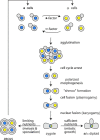Heterotrimeric G Protein-coupled Receptor Signaling in Yeast Mating Pheromone Response
- PMID: 26907689
- PMCID: PMC4824985
- DOI: 10.1074/jbc.R116.714980
Heterotrimeric G Protein-coupled Receptor Signaling in Yeast Mating Pheromone Response
Abstract
The DNAs encoding the receptors that respond to the peptide mating pheromones of the budding yeastSaccharomyces cerevisiaewere isolated in 1985, and were the very first genes for agonist-binding heterotrimeric G protein-coupled receptors (GPCRs) to be cloned in any organism. Now, over 30 years later, this yeast and its receptors continue to provide a pathfinding experimental paradigm for investigating GPCR-initiated signaling and its regulation, as described in this retrospective overview.
Keywords: G protein; G protein-coupled receptor (GPCR); Saccharomyces cerevisiae; adaptor protein; cell adhesion; cell cycle arrest; cell differentiation; cell fusion; gene regulation; mitogen-activated protein kinase (MAPK); morphogenesis; nuclear fusion; polarized morphogenesis; post-translational modification (PTM); protein phosphorylation; scaffold protein; signal transduction.
© 2016 by The American Society for Biochemistry and Molecular Biology, Inc.
Figures



References
Publication types
MeSH terms
Substances
Grants and funding
LinkOut - more resources
Full Text Sources
Other Literature Sources
Molecular Biology Databases

